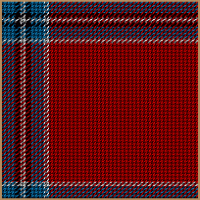Touch not a catt bot a targe.
Quartly, 1st, Or, a lion rampant Gules; 2nd, Argent, a dexter hand couped in pale Gules; 3rd, Argent, a sword in pale Proper; 4th, Or, a lymphad Azure sails furled Proper, oars in saltire Gules flagged of the Last.
A grey demi-cat-a-mountain salient, on his sinister foreleg a Highland targe Gules.
Two boxwood plants Proper.
A grey demi-cat-a-mountain as in the Crest within a chaplet of boxwood Proper.
Boxwood plants.
There are several possible Gaelic origins for this name, but the most likely appears to be 'bheathain', meaning lively one. This could also have been rendered as 'Mac'ic' Bheatha', or Macbeth, a name evocative of Scotlands early history. When Malcolm II deposed the line of Macbeth from the throne, his power was constantly challenged by the powerful noble families of Moray. Unrest continued in the region for several generations until, in the reign of Malcolm IV, the power of the mormaers of Moray was finally brocken, and various members of the family sought refuge in other parts of the kingdom. According to tradition, the ancestors of the Macbains sought out his kin among the descendents of Gillichattan Mor, more commonly called Clan Chattan.
The earliest certain record of the name in its more modern form appears in an old Kinrara manuscript of the mid 14th century, which names both Bean Macmilmhor and his son, Milmor Macbean. The Macbains supported Robert the Bruce in the struggle for Scottish independence, and they are credited with the killing of the steward of the Red Comyn, whose master had been stabbed to death by Bruce himself in the Greyfriars Church at Dumfries in 1306.
Paul Macbean, the 12th chief, was weighed down by heavy debts and was forced to relinquish his lands around 1685. The present chiefly line descends from his younger son, the elder line having ended in a daughter, Elizabeth Margaret Macbean, who married Dougald Stuart around 1790, but died without issue.
The loss of the clan lands at Kinchyle must have been sorely felt, but happily the present chief has continued the work of his father, who retreived some of the clan lands and established the Macbain memorial park on the slopes above Loch Ness.
The Macbains supported the Jacobite rising of 1715, and many were transported to the plantations in Virginia, Maryland and South Carolina after the Stuart defeat. This did not deter Gillies Mor Macbean, grandson of the 12th chief, from taking up a commission as a major to fight for Bonnie Prince Charlie, the 'Young Pretender'.
At Culloden in 1746, Gillies, a giant of a man said to be at least 6 feet 4 inches, saw government dragoons breaking through to assault the Highlanders in the flank. The major threw himself into the gap and, with his back to the wall, cut down 13 or 14 of his assailants until he himself was mortally wounded. A Hanoverian officer called back his men in an attempt to save a brave fellow soldier, but Macbean was already dead.
Other Macbains distinguished themselves on that bloody field, and it was a Macbain who assisited Cameron of Lochiel, who was wounded and unable to walk, to escape to safety.
After Culloden the chief struggled to keep the remaining clan lands together, but they were finally sold in 1760.
It was a Macbain who commanded the Gordon Highlanders against the Boers of South Africa in 1881. In this century the chiefly line has flourished, first in Canada and now in the United States.
Name Variations: Bain, Bayne, Bean, Beattie, Binnie, MacBain, MacBeth, MacBheath, MacIlvain, MacILveen, MacVain, MacVane, MacVean, MacBean, MacBeath.
References:One or more of the following publications has been referenced for this article.The General Armory; Sir Bernard Burke - 1842.
A Handbook of Mottoes; C.N. Elvin - 1860.
Scottish Clans and Tartans; Neil Grant - 2000.
Scottish Clan and Family Encyclopedia; George Way of Plean and Romilly Squire - 1994.
Scottish Clans and Tartans; Ian Grimble - 1973.
World Tartans; Iain Zaczek - 2001.
Clans and Families of Scotland; Alexander Fulton - 1991.

|
|

The beautiful heraldry artwork for this family is available to purchase on select products from the Celtic Radio Store. We look forward to filling your order!

|
|

|

Modern |